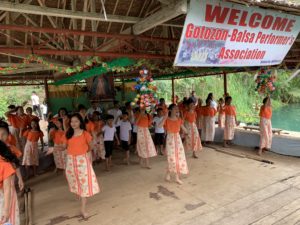Mention Bohol, and most people think of the Chocolate Hills and the tarsiers.
Those seeking the latest resorts may know of Panglao Island, just offshore from Tagbilaran.
History buffs may know of old Spanish churches or of the Dagohoy Rebellion of 1744-1829, the longest and most successful revolt against Spain.
Bohol is all these but with much more, with the unexpectedness of its attractions adding to the pleasure they provide.
To be sure, the Chocolate Hills and the tarsiers are deserving of their reputation.
Tarsier
The tarsiers are tiny creatures who sleep during the day, but this does not detract from their appeal.
Visitors follow well-laid-out paths through the recently improved and expanded viewing area, and each tarsier, whose sapling is marked by a ribbon, draws an eager cluster of viewers. They all can be viewed at the Tarsier Conservastion Area in Loboc, Bohol.
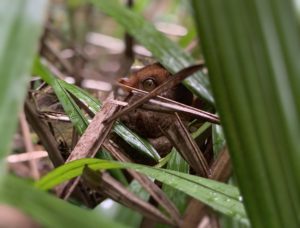
Tarsier
Chocolate Hills
The Chocolate Hills, brown in the dry season and green the rest of the year, are spectacular at any time.
They spread across three towns. Formed by a limestone cap which retards erosion, their shape is unique.
A central viewing area is accessed by a steep stairway or a less steep path. The view from the top is breathtaking.
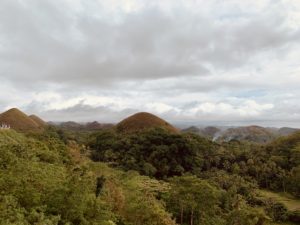
Chocolate Hills
Panglao
Most visitors to Bohol are probably attracted by Panglao’s beach resorts.
Panglao is a fairly extensive island, comprised of two towns, Dauis and Panglao, and is joined to Tagbilaran by two causeways.
The tourist area is relatively recent and still expanding, but because of Panglao’s size, the tourist presence does not seem overwhelming.
On a recent getaway in Panglao, we stayed at the Bellevue Resort in Bohol. This is one resort we would highly recommend.

The Bellevue Resort in Bohol
The facilities, beach, and service were all first-rate.
For variety of meals, their restaurant offers fresh seafood and other meat options grilled to your taste and other international favourites.
The hotel also offers island hopping exertions stopping over at Balicasag Island, home to about 1,000 residents including the banca men who ferry snorkelers from the boats to the edge of the coral reef.
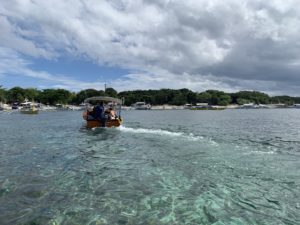
Balicasag Island
The charge for the bancas was P150 per person, while the hotel’s poses a different rate.
On our return trip, we stopped at Isola de Franceso (Virgin Island), a narrow, fenced-off, protected island in the middle of two sand spirts that disappear at high tide.
Most found the sand spits irresistible and walked fro one end into the water at the other end.
The island is also a place of meditation and reflection which is owned by the Philippine Center of St. Pio of Pietrelcina.
Baclayon Church
Six kilometers east of Tagbilaran is one of the best-preserved Jesuit churches in the region.
Dating Philippine churches is an imprecise science, because early churches were made of perishable materials, often burned, and were commonly rebuilt to larger specifications and more enduring materials.
Two Spanish Jesuit missionaries arrived in Bohol in November 1595 and established a mission at Baclayon. They soon erected a visita, a small barrio chapel.
Baclayon was the Jesuits’ first headquarters, or residencia, but fear of Moro raids soon caused them to transfer the residencia to the inland town of Loboc.
It was not until 1717 that Baclayon became a parish and construction—coral blocks cemented together with egg whites and egg shells—was started on the present church. Work was completed in 1727.
Loboc River
Loboc, besides having a church originally built in 1602 and rebuilt in 1734, has other claims to fame.
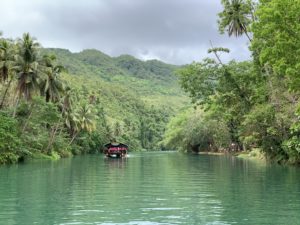
Loboc River Cruise
Construction of a new road and bridge to replace the present one-lane bridge was halted when it was realized that continuing the bridge would demolish the church. The bridge, hanging in space, remains as a testimonial to poor planning.
Boholanos have an enduring musical tradition, and the Loboc Children’s Choir, drawing heavily on Spanish church music. The choir has performed all over the world. This musical tradition was also evident in a river luncheon cruise upstream from Loboc.
A rondalla band entertained us and other passengers as we waited to board our craft.
Upstream, a chorus of children and adults on a platform beside the river serenaded each boat as it drew up. The luncheon cruise was relaxing and delightful.
The upstream cruise from Loboc features lunch. The downstream cruise from Loay features dinner and fireflies.
The male fireflies gather in particular trees, mangrove preferred, and flash their lights to attract the females hidden in the underbrush. The males communicate, and while at some trees they flash their lights at random, at others they synchronize their flashes, so that the whole tree seems to pulsate on and off.
For those used to fireflies in the garden, this is a sight like no other.
Bohol has 47 towns, most of which have massive stone churches with frescoes and other reminders of Spanish times. Few would wish to see them all, but if you plan to visit Bohol, by all means prioritise their churches.
Although we didn’t visit most of the churches, but for someone like me who is fond of reading history books, my heart would be full if you opt to visit them first before anything else. Do put them on your list. /bmjo and dbs

